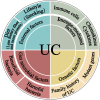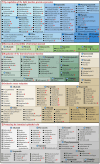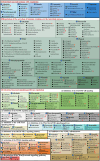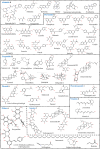Harnessing nature's pharmacy: investigating natural compounds as novel therapeutics for ulcerative colitis
- PMID: 39206263
- PMCID: PMC11349575
- DOI: 10.3389/fphar.2024.1394124
Harnessing nature's pharmacy: investigating natural compounds as novel therapeutics for ulcerative colitis
Abstract
Backgrounds: Ulcerative colitis (UC) is a form of chronic inflammatory bowel disease, and UC diagnosis rates continue to rise throughout the globe. The research and development of new drugs for the treatment of UC are urgent, and natural compounds are an important source. However, there is a lack of systematic summarization of natural compounds and their mechanisms for the treatment of UC.
Methods: We reviewed the literature in the databases below from their inception until July 2023: Web of Science, PubMed, China National Knowledge Infrastructure, and Wanfang Data, to obtain information on the relationship between natural compounds and UC.
Results: The results showed that 279 natural compounds treat UC through four main mechanisms, including regulating gut microbiota and metabolites (Mechanism I), protecting the intestinal mucosal barrier (Mechanism II), regulating intestinal mucosal immune response (Mechanism III), as well as regulating other mechanisms (Mechanism Ⅳ) such as cellular autophagy modulation and ferroptosis inhibition. Of these, Mechanism III is regulated by all natural compounds. The 279 natural compounds, including 62 terpenoids, 57 alkaloids, 52 flavonoids, 26 phenols, 19 phenylpropanoids, 9 steroids, 9 saponins, 8 quinonoids, 6 vitamins, and 31 others, can effectively ameliorate UC. Of these, terpenoids, alkaloids, and flavonoids have the greatest potential for treating UC. It is noteworthy to highlight that a total of 54 natural compounds exhibit their therapeutic effects by modulating Mechanisms I, II, and III.
Conclusion: This review serves as a comprehensive resource for the pharmaceutical industry, researchers, and clinicians seeking novel therapeutic approaches to combat UC. Harnessing the therapeutic potential of these natural compounds may significantly contribute to the improvement of the quality of life of patients with UC and promotion of disease-modifying therapies in the future.
Keywords: gut microbiota; intestinal immune responses; intestinal mucosal barrier; natural compounds; ulcerative colitis.
Copyright © 2024 Huang, Wu, Li, Lin, Yang, Zhu, Fu and Zhang.
Conflict of interest statement
The authors declare that the research was conducted in the absence of any commercial or financial relationships that could be construed as a potential conflict of interest.
Figures







Similar articles
-
The mechanism of traditional medicine in alleviating ulcerative colitis: regulating intestinal barrier function.Front Pharmacol. 2023 Oct 9;14:1228969. doi: 10.3389/fphar.2023.1228969. eCollection 2023. Front Pharmacol. 2023. PMID: 37876728 Free PMC article. Review.
-
Natural-derived alkaloids exhibit great potential in the treatment of ulcerative colitis.Pharmacol Res. 2022 Jan;175:105972. doi: 10.1016/j.phrs.2021.105972. Epub 2021 Nov 7. Pharmacol Res. 2022. PMID: 34758401 Review.
-
Traditional Chinese Medicine: A promising strategy to regulate the imbalance of bacterial flora, impaired intestinal barrier and immune function attributed to ulcerative colitis through intestinal microecology.J Ethnopharmacol. 2024 Jan 10;318(Pt A):116879. doi: 10.1016/j.jep.2023.116879. Epub 2023 Jul 5. J Ethnopharmacol. 2024. PMID: 37419224 Review.
-
Clostridium butyricum and Chitooligosaccharides in Synbiotic Combination Ameliorate Symptoms in a DSS-Induced Ulcerative Colitis Mouse Model by Modulating Gut Microbiota and Enhancing Intestinal Barrier Function.Microbiol Spectr. 2023 Mar 28;11(2):e0437022. doi: 10.1128/spectrum.04370-22. Online ahead of print. Microbiol Spectr. 2023. PMID: 36975838 Free PMC article.
-
Total flavonoids of Sophora flavescens and kurarinone ameliorated ulcerative colitis by regulating Th17/Treg cell homeostasis.J Ethnopharmacol. 2022 Oct 28;297:115500. doi: 10.1016/j.jep.2022.115500. Epub 2022 Jul 18. J Ethnopharmacol. 2022. PMID: 35863614
Cited by
-
Danggui Beimu Kushen Pill Alleviates Colitis-Induced Inflammation in Mice by Regulating the IL-6/IL-6R and IL-17A/IL-17RA Signaling Pathways.Pharmaceuticals (Basel). 2025 Jan 22;18(2):141. doi: 10.3390/ph18020141. Pharmaceuticals (Basel). 2025. PMID: 40005956 Free PMC article.
-
Immune dysregulation in ulcerative colitis: pathogenic mechanisms and therapeutic strategies of traditional Chinese medicine.Front Cell Dev Biol. 2025 Jun 5;13:1610435. doi: 10.3389/fcell.2025.1610435. eCollection 2025. Front Cell Dev Biol. 2025. PMID: 40538978 Free PMC article. Review.
References
-
- Alavala S., Sangaraju R., Nalban N., Sahu B. D., Jerald M. K., Kilari E. K., et al. (2019). Stevioside, a diterpenoid glycoside, shows anti-inflammatory property against Dextran Sulphate Sodium-induced ulcerative colitis in mice. Eur. J. Pharmacol. 855, 192–201. 10.1016/j.ejphar.2019.05.015 - DOI - PubMed
Publication types
LinkOut - more resources
Full Text Sources

